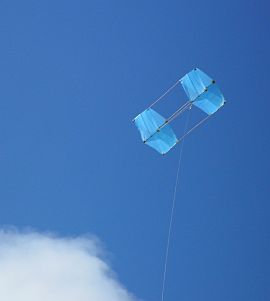- Home Page
- Flight Reports
- Sticked Boxes
MBK Box Kite Stories
Featuring Sticked MBK Boxes
Each MBK Box kite seems to have come out with a rather different wind range. Traditionally, these designs were nearly all built to fly in quite strong winds. However, one of the reports below illustrate how you can actually build a box light enough to be called a light-wind kite—although only just! This is using no space-age materials, either.
On this site, there's more kite-making info than you can poke a stick at. :-) Want to know the most convenient way of using it all?
The Big MBK E-book Bundle is a collection of downloads—printable PDF files which provide step-by-step instructions for many kites large and small.
That's every kite in every MBK series.
My latest effort, the huge MBK Multi-Dowel Box, embodies all I have learned about making these kites high-performance and tolerant of quite strong breezes.
Here's a short-format flight report featuring the 1.2 meter (4 foot) long Fresh Wind Dowel Box:
Thermaling Box!
Just to make sure it survives the next time I take it out in 40+ kph winds, the 5 millimeter cross-pieces of the MBK Fresh Wind Dowel Box were replaced with 6 millimeter dowel. Amazingly, today, this box kite still managed to thermal directly overhead in 15 to 20 kph winds!
 MBK Dowel Box scoots
MBK Dowel Box scootsIt took a few short tows to get it up there, but finally the box got its teeth into the faster air about 50 feet up. From there, it climbed to 300 feet in about three stages.
Each time, I would just let line fly off the winder as the kite floated downwind, losing height. Holding on to the line would allow the kite to steadily fly back up, and then the procedure would be repeated. I didn't let the kite dip below about 50 feet at the low points!
May (my wife) had snapped off a few photos all the while. Some featured six-year-old Aren, who was beginning to complain that the kite was pulling too hard. And this was while it was at a very high line-angle!
Soon the time came to move along to our next destination, since we were en route across the city. However, the kite was not willing. It insisted on remaining in that giant thermal, almost vertically above us, and it was a bit of a job to get the box kite down.
Near the ground, the winds averaged 5.4 kph with a peak at 17.4 kph. At 300 feet I'm guessing the average was around 15, gusting to perhaps 25. What a great flight!
Tim's Blog Posts
Featuring MBK Box Kites
Almost all of the archived posts were about the Multi-Dowel or Dowel box kites. And there were plenty of posts, so I've split them over two pages:
MBK Box Kite Posts—Multi-Dowel
Tim's Flight Reports
Featuring MBK Box Kites
The links below are full-length reports recorded by me, each featuring an MBK box of one type or another:
Successful Test in Plenty of Breeze (Multi-Dowel)
A Tale of Many Tows! (Dowel moderate)
Winds a Bit Light, But Still Flew HIGH (Dowel moderate)
An Exhilarating Fresh-Wind Single-Liner! (Dowel fresh)
Sitting Pretty Above the Wind Gradient (2-Skewer)
Floating and Darting in Gusty Fresh Winds (1-Skewer)
Reporters' Flight Reports
Click below to see MBK Flight Reporters contributions...
2-Skewer Box Kite: My All Time Favorite!
The first time I saw a box kite was by way of an illustration in a book I was reading as a child. It completely grabbed my attention, and I wanted to …
The story or stories above document actual flying experiences. My write-ups are definitely "warts and all," since things don't always go totally as planned. However, half the fun of kiting is anticipating the perfect flight. When it happens, it's magic!
As mentioned earlier, there's more kite-making info here than you can poke a stick at. :-)
Want to know the most convenient way of using it all?
The Big MBK E-book Bundle is a collection of downloads—printable PDF files which provide step-by-step instructions for many kites large and small.
That's every kite in every MBK series.

